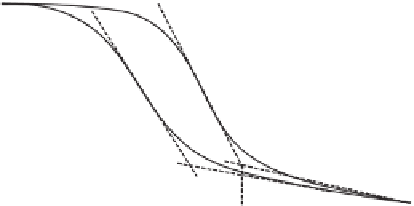Environmental Engineering Reference
In-Depth Information
13.6.5 Hysteresis Model for SWCC
The Pham and Fredlund (2011a) model for hysteretic SWCCs
based on the pore-size distribution curve can be applied to
various volume-mass constitutive pathways. The hysteresis
model for the SWCC is physically based (i.e., using pore-size
distribution) and particularly suited for geotechnical engi-
neering purposes. The pore-size distribution is described as a
function of two variables: the air-entry value and the water-
entry value of the pore (i.e., two-dimensional pore-size dis-
tribution function). Scanning SWCCs are assumed to be hor-
izontal with respect to the degree of saturation on the SWCC
(Wheeler et al., 2003). Therefore, each group of pores has a
unique relationship between drying and wetting suctions. The
relationship between the reference DPD and the reference
WPD can be described as shown in Fig. 13.39:
wG
s
V
s
Volume of water-filled pores
Volume of entrapped air
Maximum entrapped air
ψ
aev
ψ
r
10
6
Logarithmic soil suction
Figure 13.40
Volume of water-filled pores and air-filled pores
during initial drying process (from Pham, 2002).
of air entrapped in a collapsible pore is proportional to
the pore volume and can be denoted by an entrapped air
parameter,
β
(Fig. 13.40).
f
w
(ξ)
=
f
d
(ξ
−
ξ)
(13.123)
where:
13.6.6 Pham and Fredlund Volume-Mass Constitutive
Model for Saturated-Unsaturated Soils
The following equation is required to calculate the volume
of water-filled pores,
v
p
(ψ)
, at a soil suction
ψ
:
f
d
(ξ)
=
reference drying pore-size distribution,
f
w
(ξ)
=
reference wetting pore-size distribution,
ξ
=
difference between the air-entry value and water-
entry value of the group of pores having an air-
entry value of
ψ
(i.e., log-cycles), and
log
p
y
ψ
+
p
ξ
=
log(
ψ
).
v
p
(ψ)
=
v
p
(
1
,
0
)
−
V
s
C
c
log
(p
y
)
+
V
s
C
s
There are three key hysteretic SWCCs for a soil: the initial
drying curve, the bounding drying curve, and the bounding
wetting curve (Pham et al., 2005). If the distance between
curves and the slope ratio between the two bounding curves
are known, the key hysteretic SWCCs can be predicted. The
reference WPD and the reference WPD can be calculated
from the bounding SWCCs of the soil (i.e., Eq. 13.123). The
reference pore-size distribution curves (i.e., desorption and
adsorption curves) can be calculated from a single SWCC
provided the slope ratio and the distance between the drying
and wetting bounding curves is known.
The proposed model also takes into consideration the
effect of the entrapped air. It is assumed that the amount
(13.124)
where:
v
p
(
1
,
0
)
=
volume of the pore at the reference stress state
(i.e., 1 kPa soil suction and zero net normal
stress) and
p
y
=
yield stress of the pore.
The volume of air-filled pores is also stress path depen-
dent. The volume of an air-filled pore during a drying pro-
cess can be calculated as follows:
v
p
(ψ)
=
v
p
(
1
,
0
)
−
V
s
C
c
log
(p
y
)
log
p
y
ψ
aev
(p, p
y
)
+
p
V
s
C
s
+
(13.125)
S
u
The assumption is made that the volume of an air-filled
pore does not change after an unloading process. After a
loading process or a wetting process, the volume of air-filled
pores can be calculated using the following equation:
Δζ
Zero slope
S
r
v
p
(ψ)
=
v
p
(
1
,
0
)
−
V
s
C
c
log
(p
y
)
(13.126)
ψ
ψ
r
10
6
where:
Logarithmic soil suction (kPa)
p
y
=
yield stress of the pore calculated from one of the
suggested alternatives (i.e., alternative 1, 2, or 3).
Figure 13.39
Distance between two boundary curves associated
with drying and wetting for soil suction on logarithm scale.
































Search WWH ::

Custom Search